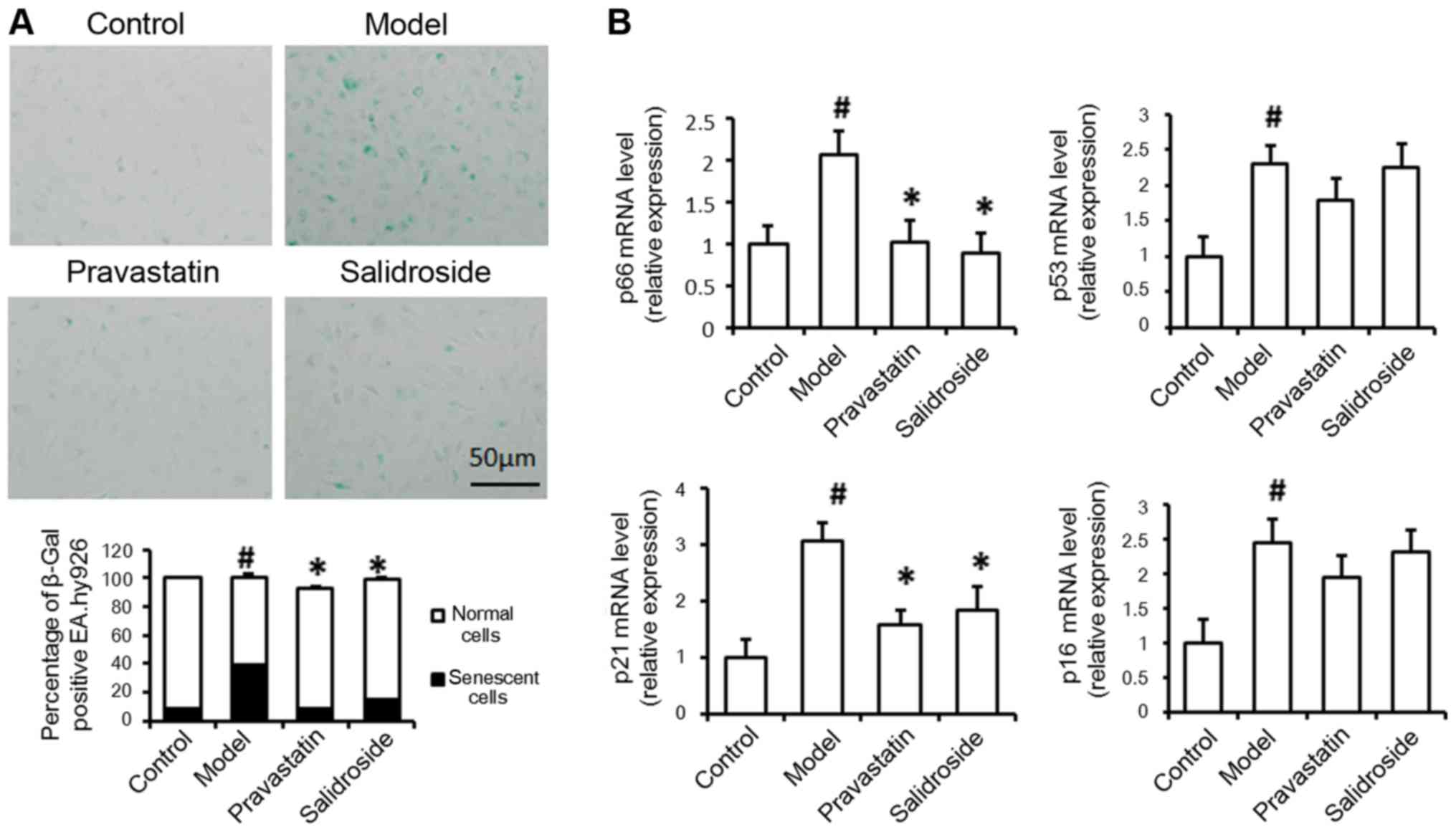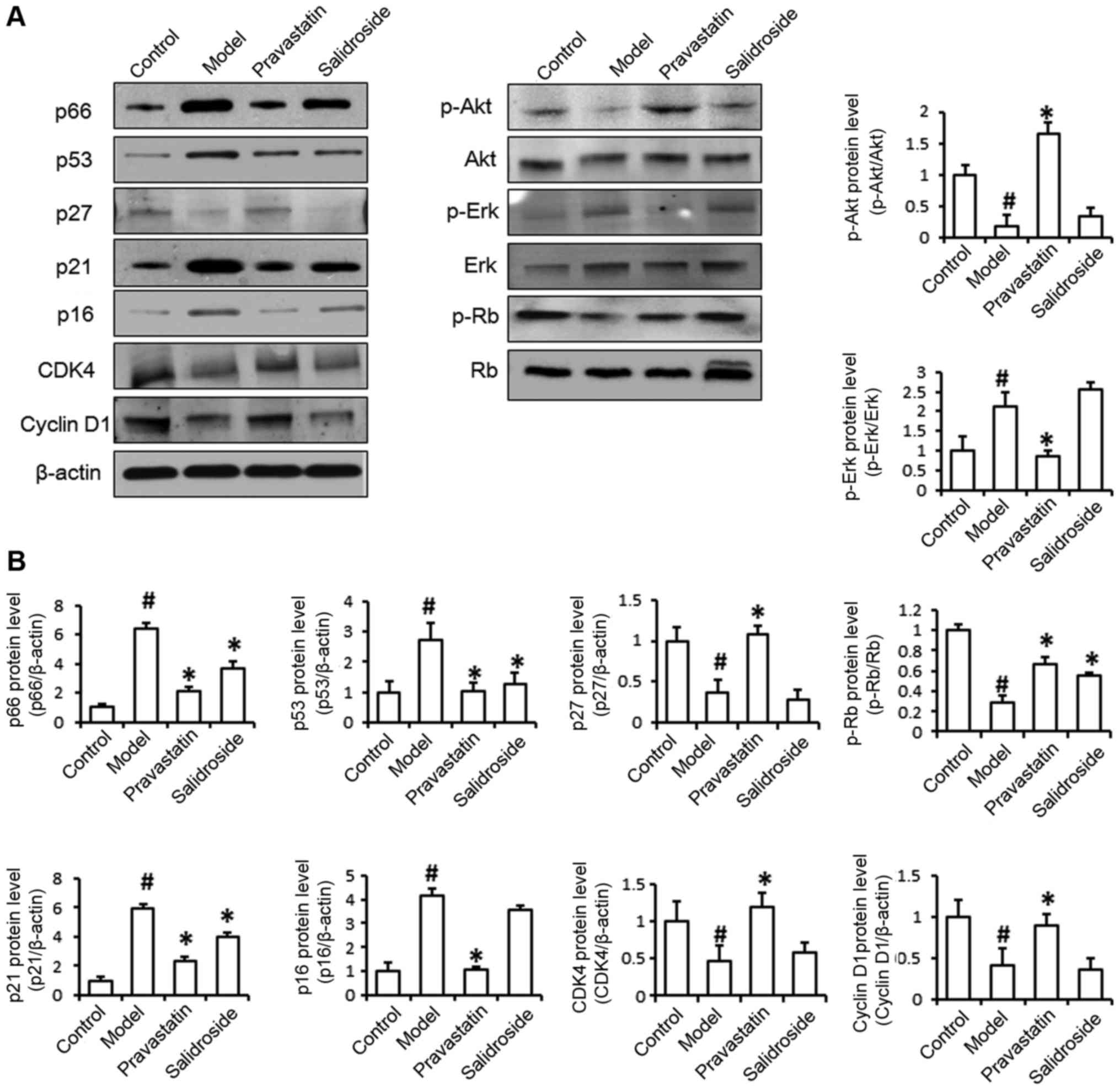|
1
|
Hashimoto J and Ito S: Aortic stiffness
determines diastolic blood flow reversal in the descending thoracic
aorta: Potential implication for retrograde embolic stroke in
hypertension. Hypertension. 62:542–549. 2013. View Article : Google Scholar : PubMed/NCBI
|
|
2
|
Li H, Horke S and Förstermann U: Vascular
oxidative stress, nitric oxide and atherosclerosis.
Atherosclerosis. 237:208–219. 2014. View Article : Google Scholar : PubMed/NCBI
|
|
3
|
Tousoulis D, Oikonomou E, Economou EK,
Crea F and Kaski JC: Inflammatory cytokines in atherosclerosis:
Current therapeutic approaches. Eur Heart J. 37:1723–1732. 2016.
View Article : Google Scholar : PubMed/NCBI
|
|
4
|
Shah P, Bajaj S, Virk H, Bikkina M and
Shamoon F: Rapid progression of coronary atherosclerosis: A review.
Thrombosis. 2015:6349832015. View Article : Google Scholar : PubMed/NCBI
|
|
5
|
Camici GG, Savarese G, Akhmedov A and
Luscher TF: Molecular mechanism of endothelial and vascular aging:
Implications for cardiovascular disease. Eur Heart J. 36:3392–3403.
2015. View Article : Google Scholar : PubMed/NCBI
|
|
6
|
Shi Y, Camici GG and Lüscher TF:
Cardiovascular determinants of life span. Pflugers Arch.
459:315–324. 2010. View Article : Google Scholar : PubMed/NCBI
|
|
7
|
Migliaccio E, Giorgio M, Mele S, Pelicci
G, Reboldi P, Pandolfi PP, Lanfrancone L and Pelicci PG: The p66shc
adaptor protein controls oxidative stress response and life span in
mammals. Nature. 402:309–313. 1999. View
Article : Google Scholar : PubMed/NCBI
|
|
8
|
Shi Y, Cosentino F, Camici GG, Akhmedov A,
Vanhoutte PM, Tanner FC and Lüscher TF: Oxidized low-density
lipoprotein activates p66Shc via lectin-like oxidized low-density
lipoprotein receptor-1, protein kinase C-beta and c-Jun N-terminal
kinase kinase in human endothelial cells. Arterioscler Thromb Vasc
Biol. 31:2090–2097. 2011. View Article : Google Scholar : PubMed/NCBI
|
|
9
|
Martin-Padura I, de Nigris F, Migliaccio
E, Mansueto G, Minardi S, Rienzo M, Lerman LO, Stendardo M, Giorgio
M, De Rosa G, et al: p66Shc deletion confers vascular protection in
advanced atherosclerosis in hypercholesterolemic apolipoprotein E
knockout mice. Endothelium. 15:276–287. 2008. View Article : Google Scholar : PubMed/NCBI
|
|
10
|
Zhou R, Han L, Li G and Tong T: Senescence
delay and repression of p16INK4a by Lsh via recruitment of histone
deacetylases in human diploid fibroblasts. Nucleic Acids Res.
37:5183–5196. 2009. View Article : Google Scholar : PubMed/NCBI
|
|
11
|
Skowronska-Krawczyk D, Zhao L, Zhu J,
Weinreb RN, Cao G, Luo J, Flagg K, Patel S, Wen C, Krupa M, et al:
P16INK4a upregulation mediated by SIX6 defines retinal ganglion
cell pathogenesis in glaucoma. Mol Cell. 59:931–940. 2015.
View Article : Google Scholar : PubMed/NCBI
|
|
12
|
Romanov VS, Pospelov VA and Pospelova TV:
Cyclin-dependent kinase inhibitor p21 (Waf1): Contemporary view on
its role in senescence and oncogenesis. Biochemistry (Mosc).
77:575–584. 2012. View Article : Google Scholar : PubMed/NCBI
|
|
13
|
Shih CT, Chang YF, Chen YT, Ma CP, Chen
HW, Yang CC, Lu JC, Tsai YS, Chen HC and Tan BC: The
PPARgamma-SETD8 axis constitutes an epigenetic, p53-independent
checkpoint on p21-mediated cellular senescence. Aging Cell.
16:797–813. 2017. View Article : Google Scholar : PubMed/NCBI
|
|
14
|
Wang M, Luo L, Yao L, Wang C, Jiang K, Liu
X, Xu M, Shen N, Guo S, Sun C and Yang Y: Salidroside improves
glucose homeostasis in obese mice by repressing inflammation in
white adipose tissues and improving leptin sensitivity in
hypothalamus. Sci Rep. 6:253992016. View Article : Google Scholar : PubMed/NCBI
|
|
15
|
Zhang B, Wang Y, Li H, Xiong R, Zhao Z,
Chu X, Li Q, Sun S and Chen S: Neuroprotective effects of
salidroside through PI3K/Akt pathway activation in Alzheimer's
disease models. Drug Des Devel Ther. 10:1335–1343. 2016.PubMed/NCBI
|
|
16
|
Yang ZR, Wang HF, Zuo TC, Guan LL and Dai
N: Salidroside alleviates oxidative stress in the liver with
non-alcoholic steatohepatitis in rats. BMC Pharmacol Toxicol.
17:162016. View Article : Google Scholar : PubMed/NCBI
|
|
17
|
Qi Z, Qi S, Ling L, Lv J and Feng Z:
Salidroside attenuates inflammatory response via suppressing
JAK2-STAT3 pathway activation and preventing STAT3 transfer into
nucleus. Int Immunopharmacol. 35:265–271. 2016. View Article : Google Scholar : PubMed/NCBI
|
|
18
|
Xing SS, Yang XY, Zheng T, Li WJ, Wu D,
Chi JY, Bian F, Bai XL, Wu GJ, Zhang YZ, et al: Salidroside
improves endothelial function and alleviates atherosclerosis by
activating a mitochondria-related AMPK/PI3 K/Akt/eNOS pathway.
Vascul Pharmacol. 72:141–152. 2015. View Article : Google Scholar : PubMed/NCBI
|
|
19
|
Zhao X, Jin L, Shen N, Xu B, Zhang W, Zhu
H and Luo Z: Salidroside inhibits endogenous hydrogen peroxide
induced cytotoxicity of endothelial cells. Biol Pharm Bull.
36:1773–1778. 2013. View Article : Google Scholar : PubMed/NCBI
|
|
20
|
Dou F, Huang L, Yu P, Zhu H, Wang X, Zou
J, Lu P and Xu XM: Temporospatial expression and cellular
localization of oligodendrocyte myelin glycoprotein (OMgp) after
traumatic spinal cord injury in adult rats. J Neurotrauma.
26:2299–2311. 2009. View Article : Google Scholar : PubMed/NCBI
|
|
21
|
Calcabrini C, De Bellis R, Mancini U,
Cucchiarini L, Potenza L, De Sanctis R, Patrone V, Scesa C and
Dachà M: Rhodiola rosea ability to enrich cellular
antioxidant defences of cultured human keratinocytes. Arch Dermatol
Res. 302:191–200. 2010. View Article : Google Scholar : PubMed/NCBI
|
|
22
|
Pooja, Bawa AS and Khanum F:
Anti-inflammatory activity of Rhodiola rosea- ‘a
second-generation adaptogen’. Phytother Res. 23:1099–1102. 2009.
View Article : Google Scholar : PubMed/NCBI
|
|
23
|
Wang J, Rong X, Li W, Yang Y, Yamahara J
and Li Y: Rhodiola crenulata root ameliorates derangements
of glucose and lipid metabolism in a rat model of the metabolic
syndrome and type 2 diabetes. J Ethnopharmacol. 142:782–788. 2012.
View Article : Google Scholar : PubMed/NCBI
|
|
24
|
Bianchi G, Di Giulio C, Rapino C, Rapino
M, Antonucci A and Cataldi A: p53 and p66 proteins compete for
hypoxia-inducible factor 1 alpha stabilization in young and old rat
hearts exposed to intermittent hypoxia. Gerontology. 52:17–23.
2006. View Article : Google Scholar : PubMed/NCBI
|
|
25
|
Hooten Noren N, Martin-Montalvo A, Dluzen
DF, Zhang Y, Bernier M, Zonderman AB, Becker KG, Gorospe M, de Cabo
R and Evans MK: Metformin-mediated increase in DICER1 regulates
microRNA expression and cellular senescence. Aging Cell.
15:572–581. 2016. View Article : Google Scholar : PubMed/NCBI
|
|
26
|
Pomari E, Stefanon B and Colitti M:
Effects of two different Rhodiola rosea extracts on primary
human visceral adipocytes. Molecules. 20:8409–8428. 2015.
View Article : Google Scholar : PubMed/NCBI
|
|
27
|
Mao GX, Wang Y, Qiu Q, Deng HB, Yuan LG,
Li RG, Song DQ, Li YY, Li DD and Wang Z: Salidroside protects human
fibroblast cells from premature senescence induced by H(2)O(2)
partly through modulating oxidative status. Mech Ageing Dev.
131:723–731. 2010. View Article : Google Scholar : PubMed/NCBI
|
|
28
|
Beauséjour CM, Krtolica A, Galimi F,
Narita M, Lowe SW, Yaswen P and Campisi J: Reversal of human
cellular senescence: Roles of the p53 and p16 pathways. EMBO J.
22:4212–4222. 2003. View Article : Google Scholar : PubMed/NCBI
|
|
29
|
Martin N, Raguz S, Dharmalingam G and Gil
J: Co-regulation of senescence-associated genes by oncogenic
homeobox proteins and polycomb repressive complexes. Cell Cycle.
12:2194–2199. 2013. View
Article : Google Scholar : PubMed/NCBI
|
|
30
|
Ben-Porath I and Weinberg RA: The signals
and pathways activating cellular senescence. Int J Biochem Cell
Biol. 37:961–976. 2005. View Article : Google Scholar : PubMed/NCBI
|
|
31
|
Nevins JR: The Rb/E2F pathway and cancer.
Hum Mol Genet. 10:699–703. 2001. View Article : Google Scholar : PubMed/NCBI
|
|
32
|
Malumbres M and Barbacid M: RAS oncogenes:
The first 30 years. Nat Rev Cancer. 3:459–465. 2003. View Article : Google Scholar : PubMed/NCBI
|


















